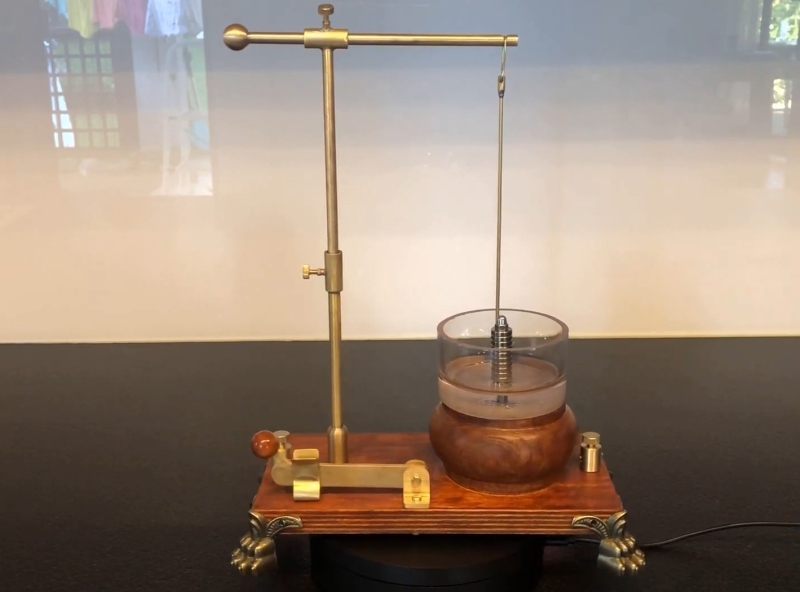Although new electric motor types are still being invented, the basic principle of an electric motor has changed little in the past century-and-a-half: a stator and a rotor built of magnetic materials plus a bunch of strategically-placed loops of wire. But getting even those basic ingredients right took a lot of experimentation by some of the greatest names in physics. Michael Faraday was one of them, and in the process became the first person to turn electricity into motion. [Markus Bindhammer] has recreated Faraday’s experiment in proper 19th century style.
Back in 1821, the very nature of electricity and its relation to magnetism were active areas of research. Tasked with writing an article about the new science of eletromagnetics, Faraday decided to test out the interaction between a current-carrying wire and a permanent magnet, in a setup very similar to [Markus]’s design. A brass wire is hanging freely from a horizontal rod and makes contact with a conductive liquid, inside of which a magnet is standing vertically. As an electric current is passed through the wire, it begins to rotate around the magnet, as if to stir the liquid.
[Markus]’s video, embedded after the break, shows the entire construction process. Starting from rods and sheet metal, [Markus] uses mostly hand tools to create all basic parts that implement the motor, including a neat knife switch. Where Faraday used mercury as the conductive liquid, [Markus] uses salt water – cheaper and less toxic, although it does eventually eat up the brass wire through electrolysis.
While not particularly useful in itself, Faraday’s motor proved for the first time that electric energy could be converted into motion through magnetism, leading to a whole class of ultra-simple motors called homopolar motors. It would be a while before experiments by the likes of Tesla and Ferraris led to modern AC motors. If you don’t like your motors magnetic, you can use electrostatics instead.
















I mean ‘technically’ not a hack. ;-)
But damn, this is nice!
It was a hack… in 1821.
Cool.
Here’s the first American electric motor patented in 1836, by Thomas Davenport.
https://americanhistory.si.edu/collections/search/object/nmah_703302
The National Museum of American History on the mall in Washington DC is really interesting and has a good collection of early electric artifacts among lots of other things.
I visit every time I’m in DC.
In ‘DC’.. Get it.. Its a ‘Current’ Joke..
“and in the process became the first person to turn electricity into motion”
Hmm… first person… electricity into motion…
Some tinkerer named Galvani might not agree:
https://www.wondriumdaily.com/how-galvanis-animal-electricity-theory-led-to-the-invention-of-the-battery/
Benjamin Franklin did achieve motion
https://hackaday.com/2017/10/03/ben-franklins-weak-motor-and-other-forgotten-locomotion/
I’m pretty sure that the caveman who noticed a lightning rod striking a tree might not agree either, but perhaps that concept of motion is less sustainable for actively driving things.
The concept of being recognized as “the first” is dubious anyway, let us agree that he was to first to be written about regarding the concept of electromagnetic movement. Or the first who bragged about it and got remembered. Now with everything somebody is to be the first, but how do you know you are actually the one? Somebody else might have done it too but never mentioned it or simply wasn’t recognized of doing it. Then there are the youtubers who cast around all sorts of “the first” videos. And 100 years from now we might not know the details anymore and assume that such a youtuber is right.
Wasn’t it Oersted who noticed a compass needle move to right angles when an adjacent wire was energized? Arguably, then, he could be said to have “discovered” the stepper motor.
good point
Low melting point alloy would also work.
Gallium would, just like the salt water, eat away the solid metal parts. It attacks aluminium particularly, but steel and other metals are also affected. Actually so does Mercury, so the original design would have had the metal weaken over timeas the Mercury liquid broke down the solid metal’s lattice structure. Is there any conductive liquid which doesn’t do bad things to solid metals?
An idea… Drill out the end of the orbiting rod… make it like one of those old cigarette holders Hollywood-types used to use. Insert a length of carbon rod into the open end so that it’s the carbon rod that contacts the liquid in the bowl, whether gallium, mercury, or what have you.
I like such projects, a lot as well, not just “hacks”, though I do consider it one.
It’s nice to see early technology, it inspires invention in other domains as well. When you think about principles and how to combine them in uncommon ways, you’ll understand connections between (physical) effects that weren’t obvious (to you or others) before.
Does anyone know how conductive coffee is, I have an experiment I want to try.
Do not pick on Faraday!!! You are nowhere close to what his IQ was! Without him be no electricity? He discovered correlation btwn magnetic field and electric!!! My 2nd fav scientists. Back off knaves!!